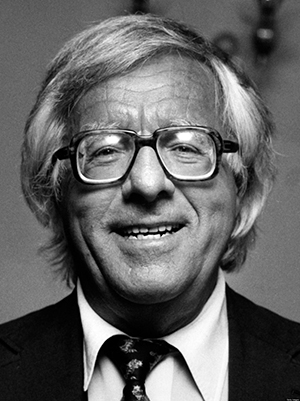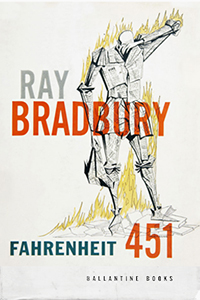Ray Bradbury
August 22, 1920–June 5, 2012
Inducted in 2021
Novels
The Martian Chronicles (1950)
Fahrenheit 451 (1953)
Dandelion Wine (1957)
Something Wicked This Way Comes (1962)
The Halloween Tree (1972)
Death Is a Lonely Business (1985)
A Graveyard for Lunatics (1990)
Green Shadows, White Whale (1992)
From the Dust Returned (2001)
Let's All Kill Constance (2002)
Farewell Summer (2006)
Short stories
"Hollerbochen's Dilemma" (1938)
"The Scythe" (1943)
"The Lake" (1944)
"Frost and Fire" (1946)
"The Million Year Picnic" (1946)
"The Small Assassin" (1946)
"I See You Never" (1947)
"Fever Dream" (1948)
"The Fruit at the Bottom of the Bowl" (1948)
"The Long Years" (1948)
"Mars Is Heaven!" (1948)
"Dark They Were, and Golden-Eyed" (1949)
"The Exiles" (1949)
"Marionettes, Inc." (1949)
"The Long Rain" (1950)
"The Rocket" (1950)
"There Will Come Soft Rains" (1950)
"The Veldt" (1950)
"Ylla" (1950)
"Embroidery" (1951)
"The Fog Horn" (1951)
"Here There Be Tygers" (1951)
"The Pedestrian" (1951)
"The April Witch" (1952)
"A Sound of Thunder" (1952)
"The Wilderness" (1952)
"The Flying Machine" (1953)
"The Golden Kite, the Silver Wind" (1953)
"The Meadow" (1953)
"The Murderer" (1953)
"Sun and Shadow" (1953)
"All Summer in a Day" (1954)
"The Dragon" (1955)
"The Aqueduct" (1979)
"Banshee" (1984)
"The Toynbee Convector" (1984)
"Is That You, Herb?" (2003)
Collections
Dark Carnival (1947)
The Illustrated Man (1951)
The Golden Apples of the Sun (1953)
The October Country (1955)
A Medicine for Melancholy (1959)
The Day It Rained Forever (1959)
The Small Assassin (1962)
R Is for Rocket (1962)
The Machineries of Joy (1964)
The Vintage Bradbury (1965)
S Is for Space (1966)
Twice 22 (1966)
I Sing the Body Electric! (1969)
Ray Bradbury (1975)
Long After Midnight (1976)
The Fog Horn & Other Stories (1979)
The Last Circus and the Electrocution (1980)
The Stories of Ray Bradbury (1980)
The Fog Horn and Other Stories (1980)
Dinosaur Tales (1983)
A Memory of Murder (1984)
The Toynbee Convector (1988)
Classic Stories 1 (1990)
Classic Stories 2 (1990)
The Parrot Who Met Papa (1991)
Selected from Dark They Were, and Golden-Eyed (1991)
Quicker Than the Eye (1996)
Driving Blind (1997)
Ray Bradbury Collected Short Stories (2001)
One More for the Road (2002)
Bradbury Stories: 100 of His Most Celebrated Tales (2003)
The Cat's Pajamas: Stories (2004)
A Sound of Thunder and Other Stories (2005)
The Dragon Who Ate His Tail (2007)
Summer Morning, Summer Night (2007)
A Pleasure to Burn (2010)
The Collected Stories of Ray Bradbury (2011, 2014)
Plays
The Meadow (1947)
The Flying Machine: A One-Act Play for Three Men (1953)
The Wonderful Ice Cream Suit and Other Plays (1972)
Pillar of Fire and Other Plays (1975)
The Martian Chronicles (1986)
The Wonderful Ice Cream Suit (1986)
Fahrenheit 451 (1986)
Dandelion Wine (1988)
The Veldt (1988)









